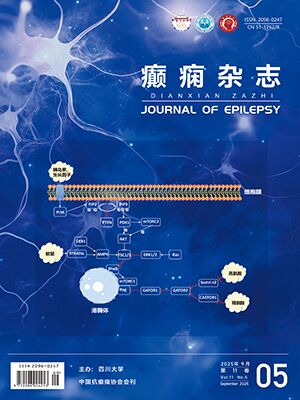| 1. |
Kirmani BF, Au K, Ayari L, et al. Super-refractory status epilepticus: prognosis and recent advances in management. Aging Dis, 2021, 12(4): 1097-1119.
|
| 2. |
Briassoulis G, Stefanogianni C, Zaganas I, et al. Specific characteristics and current diagnostic and treatment modalities performance of super refractory status epilepticus in children: A comparative study. Eur J Paediatr Neurol, 2022, 37(3): 32-39.
|
| 3. |
惊厥性癫痫持续状态监护与治疗(成人)中国专家共识. 中华神经科杂志, 2014, 47(9): 661-664.
|
| 4. |
Alolayan YS, McKinley K, Bhatia R, et al. Review and updates on the treatment of refractory and super refractory status epilepticus. J Clin Med, 2020, 10(14): 28.
|
| 5. |
Dhakar MB, Sivaraju A, Maciel CB, et al. Electro-clinical characteristics and prognostic significance ofpost anoxic myoclonus. Resuscitation, 2018, 131(10): 114-120.
|
| 6. |
Beuchat I, Sivaraju A, Amorim E, et al. MRI-EEG correlation for outcome prediction in postanoxic myoclonus: A multicenter study. Neurology, 2020, 95(4): e335-e341.
|
| 7. |
Brøchner AC, Lindholm P, Jensen MJ, et al. Post-hypoxic myoclonus status following out-of-hospital cardiac arrest-does it still predict a poor outcome? a retrospective study. Healthcare (Basel), 2021, 10(1): 41.
|
| 8. |
Freund B, Kaplan PW. Post-hypoxic myoclonus: differentiating benign and malignant etiologies in diagnosis and prognosis. Clin Neurophysiol Pract, 2017, 2: 98-102.
|
| 9. |
Shebak SS, Bader G. Midazolam and low magnesium associated with myoclonic jerks: a case report. Prim Care Companion CNS Disord, 2015, 7(2): 10.
|
| 10. |
Naylor DE, Liu H, Niquet J, et al. Rapid surface accumulationof NMDA receptors increases glutamatergic excitation during status epilepticus. Neurobiol Dis, 2013, 54: 225-238.
|
| 11. |
梁锦平. 儿童难治性癫痫持续状态的病理生理学及诊治策略进展. 中华儿科杂志, 2018, 56(3): 713-716.
|
| 12. |
Alolayan YS, McKinley K, Bhatia R, et al. Review and updates on the treatment of refractory and super refractory status epilepticus. J Clin Med, 2021, 10(14): 3028.
|
| 13. |
Kusztos AE, Coppler PJ, Salcido DD, et al. Neuro-anatomical localization of EEG identical bursts in patients with and without post-anoxic myoclonus. Resuscitation, 2021, 16(3): 314-319.
|
| 14. |
Ben HSO, Jamme M, Paul M, et al. Post-cardiac arrest myoclonus and in ICU mortality: insights from the Parisian Registry of Cardiac Arrest (PROCAT). Neurol Sci., 2022, 3(1): 533-540.
|
| 15. |
Sandroni C, D'Arrigo S, Cacciola S, et al. Prediction of poor neurological outcome in comatose survivors of cardiac arrest: a systematic review. Intensive Care Med, 2020, 46(10): 1803-1851.
|
| 16. |
Chomtho S, Uaariyapanichkul J, Chomtho K. Outcomes of parenteral vs enteral ketogenic diet in pediatric super-refractory status epilepticus. Seizure, 202, 96(3): 79-85.
|
| 17. |
Tai KK, Truong DD. Ketogenic diet prevents seizure and reduces myoclonic jerks in rats with cardiac arrest-induced cerebral hypoxia. Neurosci Lett, 2007, 425(1): 34-38.
|




